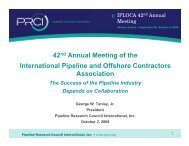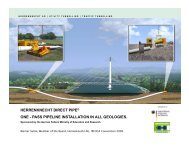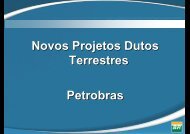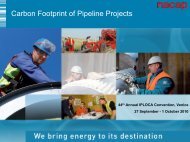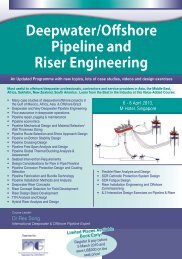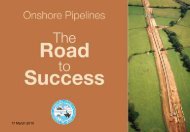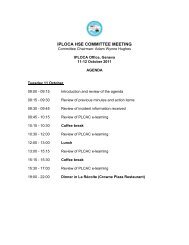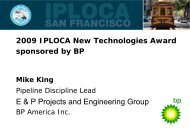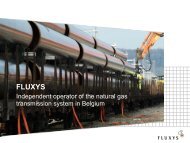EPRG-PRCI-APIA 17th JOINT TECHNICAL MEETING ON ... - Iploca
EPRG-PRCI-APIA 17th JOINT TECHNICAL MEETING ON ... - Iploca
EPRG-PRCI-APIA 17th JOINT TECHNICAL MEETING ON ... - Iploca
Create successful ePaper yourself
Turn your PDF publications into a flip-book with our unique Google optimized e-Paper software.
Workshop 3: Pipe materials and properties (including fracture control)<br />
<strong>PRCI</strong> Project MAT-4-4<br />
The objective is to develop an enhanced model, based on the J-T analysis approach, to<br />
predict the start of ductile tearing (initiation of the fracture event) and maximum failure<br />
pressure of an axial crack in a high strength line pipe. The model will be validated via smallscale<br />
fracture specimens and full-scale pipe tests.<br />
<strong>PRCI</strong> Project MAT-8: Criteria for determining seam failure susceptibility due to crack<br />
defects<br />
Research is aimed at developing methodologies for assessing the significance of crack-like<br />
defects in ERW pipelines. The methodology is developed from the principles in BS 7910,<br />
but with significant differences in detail at Level 2. The Level 3 methodology is J-based<br />
rather than FAD-based.<br />
<strong>PRCI</strong> Project PR-276-04505: Improvements in two-curve ductile fracture arrest models<br />
The project aims to improve the accuracy of the two-curve ductile fracture model by<br />
accounting for different types of soil backfill, based on a series of full-scale burst tests with<br />
different soil types and moisture content<br />
<strong>PRCI</strong> Project MATH-4-6: Validation of dry-fibre wrapped steel pipe<br />
The project aims to qualify the fabrication, long-term performance, damage tolerance, repair,<br />
corrosion control and installation techniques for dry fibreglass wrapped steel pipe, to<br />
promote approval of the product by NEB and PHMSA for high pressure gas pipeline<br />
applications.<br />
<strong>APIA</strong> Project 1.2.10: The effect of pipe diameter on the decompression velocity of rich<br />
gas<br />
The Battelle two curve model (BTCM) does not account for diameter in the determination of<br />
decompression velocity and hence fracture arrest toughness levels. Limited data generated<br />
by <strong>PRCI</strong> suggests that decompression is significantly slower in small diameter pipelines.<br />
This needs confirmation. If it is so then the fracture control methods used for small diameter<br />
pipelines may not be safe.<br />
The <strong>APIA</strong>-RSC is preparing to undertake shock tube tests at a diameter intermediate to the<br />
very small (DN50) pipe and the typical large diameter pipelines (> DN750) for which data<br />
currently exists. It is hoped to be able to involve <strong>PRCI</strong> and/or <strong>EPRG</strong> in a new proposal under<br />
development.<br />
<strong>EPRG</strong> Project 123. Pipe properties: strength de-rating factors at elevated<br />
temperatures<br />
Strength de-rating factors are used for line pipe and fittings located in the vicinity of<br />
compressor discharges, where the operating temperatures can be above ambient. Several<br />
codes provide such strength de-rating factors, but they are inconsistent in both the<br />
magnitude of the reduction and the temperature below which such effects can be<br />
discounted. <strong>EPRG</strong> commissioned a review and limited experimental project to address<br />
these shortcomings. For most of the steels studied there was a sharp reduction in proof<br />
strength at 60°C compared with the room temperature value, but little further change as the<br />
temperature increased to 150°C<br />
<strong>EPRG</strong> Project 126: X100 Grade steel for pipelines<br />
In recent years <strong>EPRG</strong> has played a significant role in supporting initiatives to enhance the<br />
knowledge base for X100 line pipe and its applicability to highly-rated pipelines. In<br />
particular, <strong>EPRG</strong> has partially sponsored a Demonstration Project – Demopipe - to establish<br />
the pipe production and properties, field welding, field bending and fracture control<br />
methodology. Some 50 full-length seam-welded pipe joints were produced, and welding<br />
procedures were developed and qualified for automated and manual girth welds. Field<br />
bending procedures were developed and tested. Two full-scale fracture propagation tests



